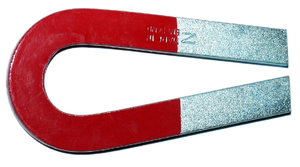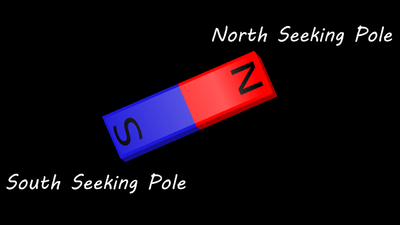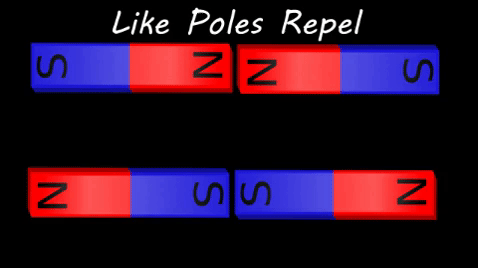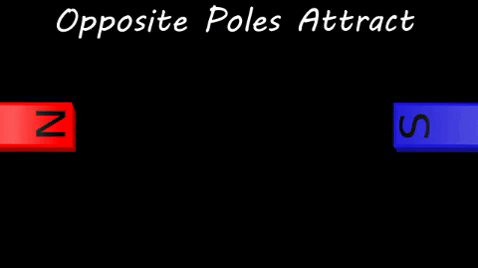Difference between revisions of "Magnet"
| Line 18: | Line 18: | ||
===About Magnets=== | ===About Magnets=== | ||
: '''Magnets''' are [[attract]]ed to some metals. Those metals are '''magnetic''' but they are not [[magnet]]s themselves. | : '''Magnets''' are [[attract]]ed to some metals. Those metals are '''magnetic''' but they are not [[magnet]]s themselves. | ||
| − | : '''Magnets''' have two poles; North and South. | + | : '''Magnets''' have two [[poles]]; North and South. |
| − | : When two North Poles are placed next to each other two '''magnets''' will [[repel]] each other. | + | : When two North [[Poles]] are placed next to each other two '''magnets''' will [[repel]] each other. |
| − | : When two South Poles are placed next to each other two '''magnets''' will [[repel]] each other. | + | : When two South [[Poles]] are placed next to each other two '''magnets''' will [[repel]] each other. |
| − | : When the North Pole of one '''magnet''' is placed next to the South Pole of another '''magnet''' they attract each other. | + | : When the North [[Poles|Pole]] of one '''magnet''' is placed next to the South [[Poles|Pole]] of another '''magnet''' they [[attract]] each other. |
===Examples=== | ===Examples=== | ||
| Line 46: | Line 46: | ||
: [[Magnet]]s can be [[Permanent Magnet]]s, [[Induced Magnet]]s or [[Electromagnet]]s. | : [[Magnet]]s can be [[Permanent Magnet]]s, [[Induced Magnet]]s or [[Electromagnet]]s. | ||
: '''Magnets''' are [[attract]]ed to some metals. Those metals are '''magnetic''' but they are not [[magnet]]s themselves. | : '''Magnets''' are [[attract]]ed to some metals. Those metals are '''magnetic''' but they are not [[magnet]]s themselves. | ||
| − | : '''Magnets''' have two poles; North and South. | + | : '''Magnets''' have two [[poles]]; North and South. |
| − | : When two North Poles are placed next to each other two '''magnets''' will [[repel]] each other. | + | : When two North [[Poles]] are placed next to each other two '''magnets''' will [[repel]] each other. |
| − | : When two South Poles are placed next to each other two '''magnets''' will [[repel]] each other. | + | : When two South [[Poles]] are placed next to each other two '''magnets''' will [[repel]] each other. |
| − | : When the North Pole of one '''magnet''' is placed next to the South Pole of another '''magnet''' they attract each other. | + | : When the North [[Poles|Pole]] of one '''magnet''' is placed next to the South [[Poles|Pole]] of another '''magnet''' they [[attract]] each other. |
Revision as of 19:42, 31 October 2018
Contents
Key Stage 1
Meaning
A magnet is an object that sticks to some metals.
About Magnets
- Magnets are very useful. We can use them to stick notes to the fridge.
Key Stage 2
Meaning
A magnet is a piece of equipment that can be used to do determine if a material is magnetic.
About Magnets
- Magnets are attracted to some metals. Those metals are magnetic but they are not magnets themselves.
- Magnets have two poles; North and South.
- When two North Poles are placed next to each other two magnets will repel each other.
- When two South Poles are placed next to each other two magnets will repel each other.
- When the North Pole of one magnet is placed next to the South Pole of another magnet they attract each other.
Examples
| Magnets are attracted to some metals. Those metals are magnetic but they are not magnets themselves. | Magnets have two poles; North and South. |
| Two magnets facing North-North will repel each other and two magnets facing South-South will repel each other. | Two magnets facing North-South will attract each other. |
Key Stage 3
Meaning
A magnet is an object that attracts Iron, Cobalt or Nickel.
About Magnets
- Magnets can be Permanent Magnets, Induced Magnets or Electromagnets.
- Magnets are attracted to some metals. Those metals are magnetic but they are not magnets themselves.
- Magnets have two poles; North and South.
- When two North Poles are placed next to each other two magnets will repel each other.
- When two South Poles are placed next to each other two magnets will repel each other.
- When the North Pole of one magnet is placed next to the South Pole of another magnet they attract each other.




